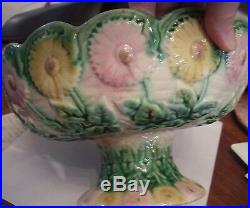
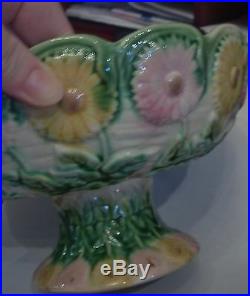
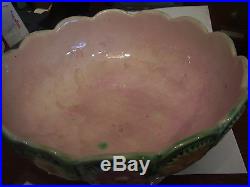
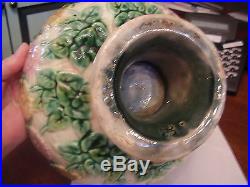
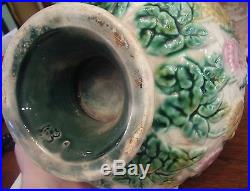
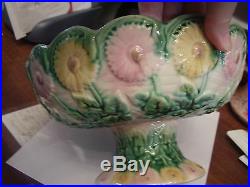
40 years experience quality art and antiques dealer. MAJOLICA COMPOTE pedestal bowl PINK AND YELLOW FLOWERS, WITH GREEN ACCENTS. PINK CENTER shows some staining. 5 inches tall, 8 3/4 inches across top. Wonderful artistic design style. Free public information from on online source. M ajolica is a soft earthenware ceramic, fired to the “biscuit” or unglazed stage at approximately 1100 degrees Fahrenheit. Once the plaster of Paris molds are removed, the resulting form is then covered with a coat of an opaque lead glaze. Later, when this has set or dried, the brightly colored metal oxide glazes are added on top of this first lead glaze coating. When fired for the second time, this time at 750 degrees, the interaction of the water which remained in the biscuit form, the opaque lead glaze and the final metal oxide glazes interact in the kiln to create the deep and brilliant translucent color specific to majolica. It is this glaze, the tremendous variety of whimsical forms, and the intense colors of majolica that make this ceramic stand apart from other wares and delight collectors. These techniques were developed from third century Middle Eastern glazes, forms originated in eighth century Spain, and united by the maiolica of Renaissance Italy. The Victorian majolica to which this site pertains was made during the latter half of the nineteenth century. Herbert Minton, a true visionary and astute merchant, saw the opportunity to introduce a new commodity to the English home. After decades of use of white ironstone, blue and white china, and other everyday drab stoneware, Minton recognized the need for a new ceramic. The time was ripe the Industrial Revolution was providing more disposable income. Minton correctly judged that in his Stoke-on-Trent location in Staffordshire, England, he had the facilities necessary for the production of majolica. His need for a glazing expert was fulfilled by Leon Arnoux, a French ceramic chemist. Due to difficulties in France during the third Napoleanic era, Minton was able to convince Arnoux to come to England and to join Minton & Co. In the development and production of Victorian majolica. Together, they introduced majolica at the Crystal Palace Exhibition in London in 1851, where Queen Victoria and the public at large became instantly enamored with the new ware. Mintons international artists drew upon the art revival styles from the Renaissance to the emerging Art Nouveaux. For the next forty years, Victorian majolica held a position of prominence at most of the major international exhibitions on both sides of the Atlantic. Large and small potteries, in England and on the continent, and later in the United States, produced majolica. By the 1870s majolica was a household word and was in wide every day use, both on the dining table and in the garden. At the turn of the century, however, production standards deteriorated, trends and tastes changed, and majolica became unfashionable. Majolica was unappreciated and largely relegated to “grandmas attic” for the first seventy years of the 20th century. A renaissance occurred in the seventies and eighties with the new general appreciation of Victoriana. Majolica became fashionable in home and garden decorations, books and magazines articles were written. It became an important accessory in advertisements in prominent magazines. Today, major collections have been developed, and finally, majolica has become recognized for its aesthetic, historic, and intrinsic worth. All items are antique, vintage, and / or estate pieces and should be considered to have some wear or signs of use typical for their age. Obvious damage tears, chips, cracks, holes, etc. Please refer to the photos to access overall condition and age wear of items. If the carrier was U. We are glad to assist you with your documentation. If the item was sent by UPS, please notify us and we will put through the claim according to UPS stipulations. The item “MAJOLICA COMPOTE pedestal bowl, pink and yellow flowers, vintage, estate” is in sale since Sunday, February 2, 2014. This item is in the category “Pottery & Glass\Pottery & China\Art Pottery\Majolica”. The seller is “paintformoney” and is located in Smithfield, Virginia. This item can be shipped to United States.
- Main Color: Multi Color
- Original or Reproduction: Original
- Category, Maker: MAJOLICA